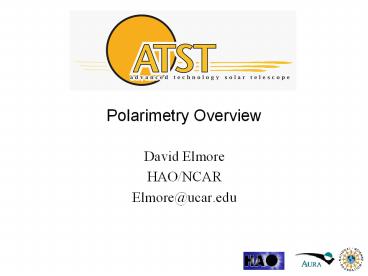Polarimetry Overview - PowerPoint PPT Presentation
1 / 13
Title:
Polarimetry Overview
Description:
Polarimeter Guidelines. Time multiplexed polarization modulation and analysis ... Time varying polarimeter response matrix. Calibration intensive data ... – PowerPoint PPT presentation
Number of Views:323
Avg rating:3.0/5.0
Title: Polarimetry Overview
1
Polarimetry Overview
- David Elmore
- HAO/NCAR
- Elmore_at_ucar.edu
2
Polarimeter Guidelines
- Time multiplexed polarization modulation and
analysis - Issues are understood
- Versatile
- Calibration optics precede highly polarizing
reflections (Calibration station at Gregory
focus) - Polarization modulators precede highly polarizing
reflections (Modulator turret at Gregory focus) - Seeing induced errors reduced at high modulation
frequency (kHz) - Seeing induced errors reduced using dual beam
analyzer
3
Polarimeter Concept (HPP)
- High Precision Polarimeter
- Modulator at Gregory
- High speed Piezo-elastic (PEM)
- Ferroelectric liquid crystal (FeLC)
- Analyzer Linear polarizer at Gregory
- Advantages
- kHz modulation frequency rejects residual seeing
- No highly polarizing optics between modulator and
analyzer - Disadvantages
- Narrow wavelength range, but tunable
- Charge caching photo-detector required
4
Polarimeter Concept (FAP)
- Fast Achromatic Polarimeter
- Modulator Rapidly rotating achromatic retarder
at Gregory (but not as fast as FeLC or PEM) - Analyzer at detector Linear polarizer for
8-state modulation or high frequency FeLC
linear polarizer for 4-state modulation - Advantages
- Hundreds of Hz modulation frequency helps reject
residual seeing - Wavelength diversity possible
- Disadvantages
- Highly polarizing optics between modulator and
analyzer - Time varying polarimeter response matrix
- Calibration intensive data collection and
reduction - Charge caching photo-detector required
5
Polarimeter Concept (SAP)
- Slow Achromatic Polarimeter
- Modulator Achromatic slowly rotating retarder at
Gregory - Analyzer Polarizing beam splitter at detectors
- Advantages
- Wavelength diversity possible
- Conventional CCD or IR detectors can be mixed
with charge caching photo-detectors (that use
rapidly chopped FeLC before analyzer) - Disadvantages
- Highly polarizing optics between modulator and
analyzer - Time varying polarimeter response matrix
- Calibration intensive data collection and
reduction - Charge caching detector needed for mixed scheme
6
Polarimeter Performance
Depends upon modulator type and particular
lines Additional study required
7
Further Analysis Fast Retarder
- Fast modulation using a retarder
- Up to 1600Hz frame rate gt 200Hz to 400Hz
polarization modulation - 8 state demodulation
- 4 state demodulation using FeLC at the analyzer
8
Further Analysis Fast Retarder
9
Further Analysis Slow Retarder Fast Analyzer
- Slow modulation using a retarder
- Typically 50 Hz frame rate gt 12.5Hz 25Hz
polarization modulation - 8 state demodulation
- Rapidly chopped analysis using FeLC at the
analyzer
10
Further Analysis Slow Retarder Fast Analzer
11
Phils Analysis
12
Bottom Line
requirement
requirement
13
Further Analysis Conclusions
- Slow modulation using a retarder (50hz frame
rate) - Does not meet accuracy requirement
- Superimposition of rapidly chopped analyzer does
not help - Fast modulation using a retarder
- Meets accuracy requirement for dual beam but not
single - 4 state chopped analyzer helps V, but not Q.
Good for reducing number of modulation states - How does FeLC or PEM perform?































